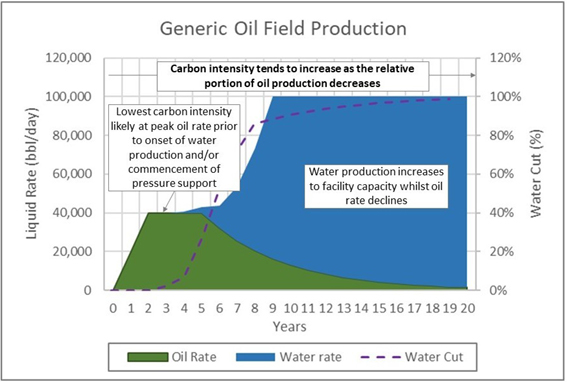
Barny Brennan
Provision of consultancy services, specialising in Oil and Gas and the Energy Transition
To meet net zero targets, society must massively reduce its reliance on fossil fuels. However, projections of how we achieve this shows a continued but diminished fossil fuel usage for decades to come. Given an ongoing demand for oil and gas in the UK, it is essential that the oil and gas industry supplies these at minimum carbon intensity. My earlier article argued that part of the route to achieving this was to prioritise domestic production over imports - see https://www.linkedin.com/pulse/how-do-we-minimise-carbon-emissions-associated-oil-gas-barny-brennan/). This new article explores some of the challenges of decarbonising mature fields and considers whether we should prioritise production from new low emission developments.

I recently hosted a session for the SPE London Section on decarbonising oil and gas production https://www.linkedin.com/feed/update/urn:li:activity:6844259587147747328/. One thing the session highlighted for me was the different challenges faced by mature fields compared to new fields when it comes to minimising the carbon intensity of oil production hence I wanted to explore this further.
Paradoxically, new fields have the greatest potential for producing low carbon intensity oil but face significant challenges for funding, regulatory approval, and social acceptance, whilst mature fields might have relatively high carbon intensity production with fewer viable options for reducing emissions, but they can continue to produce relatively unchallenged.
What is carbon intensity and how does it vary? Briefly, carbon intensity is a measure of the amount of CO2, or green house gas equivalents, emitted per barrel of oil produced. It will vary from country to country based on the regulatory regime (eg regulations around venting or flaring methane will have a significant impact on countrywide emissions), it will vary from field to field based on the specific properties of the field, but also it will vary within a field across its lifetime.
Total emissions can be calculated as production volumes multiplied by the carbon intensity of the production. In a given period we can halve our emissions by halving production or by halving the carbon intensity of the production. Do both, and emissions drop by a factor of four.
In the UK, where there has been a concerted effort to minimise venting and flaring of methane, the primary source of production related emissions is the burning of fossil fuels (usually gas) to generate electrical power and/or heat. Clearly, switching this power generation away from burning fossil fuels to a clean electricity source will dramatically reduce field emissions. The OGA are pushing efforts for platform electrification https://www.ogauthority.co.uk/the-move-to-net-zero/platform-electrification/ but at present none of the UK’s oil fields have been converted to clean electricity. Electrification of offshore assets appears to be critical to deep decarbonisation of oil and gas production, however converting to electrical power is not straightforward especially for older infrastructure where brownfield modifications can be challenging and where the remaining asset life is too short to repay the cost of conversion. Unfortunately, it may be some of these older fields that have the highest carbon intensity.
How does carbon intensity change over field life? There will be a portion of electrical power used for base load on the facility (ie keeping the lights on) that will remain relatively constant through field life but the majority of power is likely to be associated with compressing and/or pumping fluids and this will vary over field life.

No two fields are the same but generally the production profile will look something like in the graph. As wells come on stream and facilities are commissioned there is typically a ramp-up in oil rate to some plateau determined by facility capacity. At this point oil and any associated gas are the only produced fluids and none of the power is going into moving waste fluid in the form of water. This period most likely represents the lowest carbon intensity production of the entire field life. After a period of production, fields without natural pressure support will likely commence a water injection scheme to maintain reservoir pressure and thereby the plateau oil production rate. This will require additional power for treating and injecting the water and - with no increase in the plateau oil rate - it follows that the carbon intensity of production increases. Whether a water injection scheme is deployed for pressure support or whether there is enough natural aquifer pressure to provide support, a time will inevitably come when the field starts producing water - likely a combination of injected and aquifer water. Water production volumes will increase up to the facility handling capacity and the ratio of water produced to oil will also increase. Handling this additional water, and reinjecting it into the reservoir, requires additional power at a time when oil production is decreasing. As a result, carbon intensity of production increases further. In other words, carbon intensity of production is likely to be significantly higher in late field life than in early life.
Late field life production may therefore be high carbon intensity but also (as noted above) relatively hard to decarbonise. From an operator perspective the benefits of maintaining late life production are partly continued cash flow but often more significantly the deferral of decommissioning costs. Deferral of decommissioning can have the added advantage that the assets such as platforms, pipelines and wells could be repurposed in support of other parts of the energy sector such as for carbon capture and storage or hydrogen. However, some facilities are beyond their usable life, so care should be taken that the potential reutilisation of facilities is not just used as an excuse for deferring cessation of production and decommissioning of high carbon intensity fields.
How then do emissions compare for a new field coming into production relative to the late life of an existing field? Again, there are no hard and fast rules, however there are some useful pointers. Most current UK fields came into production prior to UK net zero legislation and would have been designed to maximise economic return within the regulatory framework at the time, which was looser on CO2 emissions than the current regime. New field developments have to be designed such that lifetime emissions are minimised in order to gain regulatory approval for the development and in order to access funding at a reasonable cost. Fortunately, it is easier to design a low emission scheme for a new development than it is to upgrade and retrofit low emission technology on an existing development. New developments can take advantage of the latest technology, can utilise electrification without expensive brownfield modifications, and can have a reservoir management scheme that focuses on minimising field life power requirements by improving the overall ratio of oil produced to unwanted water such as through effective use of autonomous inflow control devices (AICDs) (eg https://www.tendeka.com/news-current/sustainable-oil-production/) or polymer floods (eg https://orcadian.energy/wp-content/uploads/2021/09/2021-09-14-Net-Zero-Basin.pdf).
So, should we prioritise new low emission fields over late field life production? On the premise that we need to lower the average carbon intensity of production and that new fields will generally have lower intensity, then yes, a case can be made for this. The reality is more complicated. Firstly, the commissioning of any new fields is likely to face a political and societal backlash unless it can be clearly articulated that it is being done in support of, rather than against, net zero objectives. Also, if late field life production is demonstrably low carbon intensity, or an electrification project can be justified, or if there is a clear repurposing strategy for the field’s assets, then continued production supports the overall net zero goals. In the more likely scenario that late life production is relatively high carbon intensity then, if we can replace it with lower intensity production whilst meeting the demand curve, we will be helping to drive down emissions. This could mean earlier decommissioning of old fields and a ramp up in production of new low emission fields. However, if decommissioning old fields leaves a supply gap that is filled by high carbon intensity imports then we have not improved the emissions. A careful analysis is therefore required to ascertain the carbon intensity of each element of the UK supply, be it from domestic production or imports. The OGA emissions benchmarking scheme https://www.ogauthority.co.uk/the-move-to-net-zero/net-zero-benchmarking-and-analysis/emissions-benchmarking/ coupled with increased reporting of emissions as part of their stewardship programme https://www.ogauthority.co.uk/exploration-production/asset-stewardship/surveys/ should help identify where emissions are coming from. Armed with that knowledge a strategy can be put in place to lower average carbon intensity. One possible mechanism that might incentivise such a reduction would be a tiered tax regime based on carbon intensity of production.
Over the coming decades society must massively reduce its consumption of oil and gas and related products, and the oil industry has to ensure that the supply of fossil fuels to meet the demand is done whilst minimising emissions. This will require a relentless focus on the carbon intensity of production and a progressive move to lower and lower intensity sources. If the lowest carbon intensity production can come from new field developments, then we need to work on the acceptability of prioritising these.
KeyFacts Energy: Commentary
 KEYFACT Energy
KEYFACT Energy